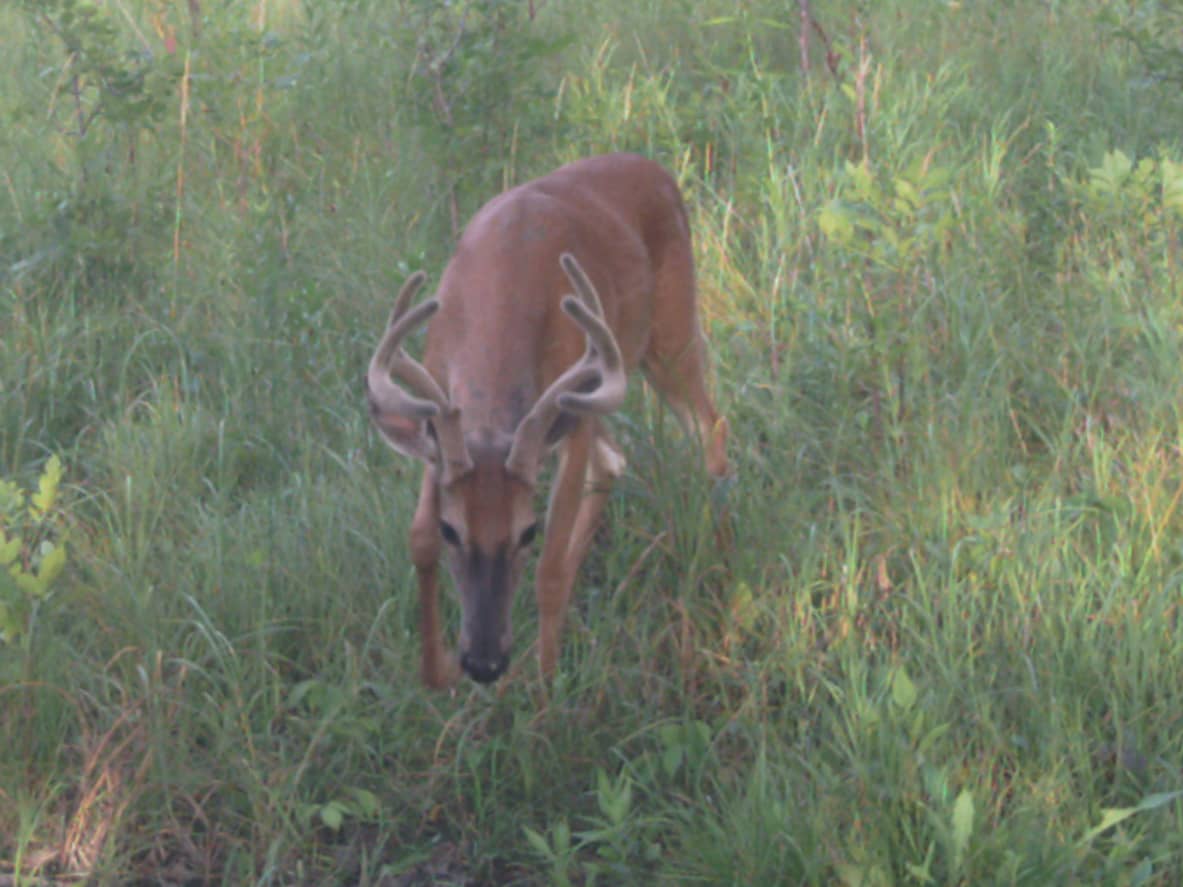
Velvet Visitor. North Dakota’s uniquely timed deer archery season gives bowhunters a chance to tag a buck with velvet antlers. Simonson Photo
By Nick Simonson
A winter filled with heavy snows across southeastern North Dakota is a distant memory, as the moisture packed in those drifts gave way to growing fields of grass and a greening landscape following the drought of 2021. This, along with spring and early summer rains, helped provide nearly ideal fawning habitat for the region’s whitetail deer as ground cover grew tall to help conceal the young from predators and provide a boost to forage to help the herd recover from winter’s stressors, according to Jason Smith, Big Game Biologist for the North Dakota Game & Fish Department’s Jamestown Office.
“We had a real winter for the first time in a couple of years, and the deer look to have handled that really well, but that moisture in the form of snow was greatly needed as well as those spring rains,” Smith states, adding that the growth of habitat spurred good fawning conditions, “it looks like there’s a good number of fawns with does, especially multiples,” he concludes.
The only shadow hanging over the region is the darkening of unit 2B on the NDG&F deer hunting unit map, designating it as one with restrictions for hunting over bait, after a whitetail deer on the Minnesota side of the Red River tested positive for chronic wasting disease (CWD) last year just before the North Dakota firearms deer season started. That designation came in reaction to a 2.5-year-old buck harvested by a bow hunter near Climax, Minn., and sampled by that state’s Department of Natural Resources. This season, Smith urges archery deer hunters in the southeast to familiarize themselves with the restrictions and be observant of deer behavior.
“If hunters haven’t already done so, they should visit our webpage and check out the CWD section. Take a moment to familiarize yourself with the regulations that we have in place aimed at limiting the spread of CWD,” Smith suggests adding that, “if they harvest a deer that looks unhealthy, or they see one out on the landscape that looks like they’re in poor condition, or have any questions, [hunters should] contact the department, any district office, or any district game warden,” and a report can be made and investigated by the agency.
The timing of the start of North Dakota’s archery season provides hunters with a unique opportunity to harvest a buck with velvet still on its antlers, but the window is very short. With opening day set for noon on Fri. Sept. 2, there is some overlap between the front end of the season and the usual biological timetable for when deer begin losing the velvet material around their antlers.
“As far as the process goes for velvet shedding, the timeline is about a month. Generally speaking, it begins in later August and can run all the way into September. Obviously, that varies by individual deer; some bucks can shed early. For the most part it seems like that the first week in September seems to be that timeframe where most of the deer are starting to shed out of velvet. Usually quite a few are hard antlered by late September or into October.”
Whether in velvet or not, hunters can expect a good season, based on quality of habitat and forage, and a crop harvest schedule which appears only slightly behind normal, based on Smith’s observations and the USDA National Agriculture Statistics Service, which shows both corn and soybeans being a bit off pace with the five-year average, likely due to a later start in planting this spring. With all there is to eat, and a lush landscape throughout the summer, Smith suggests whitetail bucks may sport bigger racks, and those looking to harvest one with the bow should have plenty of opportunity to do so, with a little work.
“It should be a great year from what we’ve been seeing, it appears that deer are doing really well. As it relates to buck antler growth, it looks like it’s going to be really good this year based on the timely rains that we got and the abundant forage out there. I’d say anyone heading into the field and able to put in the time should be able to find reasonable success in harvesting a deer,” he concludes.
The North Dakota Archery Deer Season begins at noon on September 2. More information on CWD can be found at gf.nd.gov/wildlife/diseases/cwd. USDA crop status and harvest reports can be found under the Crop Progress and Condition link at www.nass.usda.gov/Statistics_by_State/
